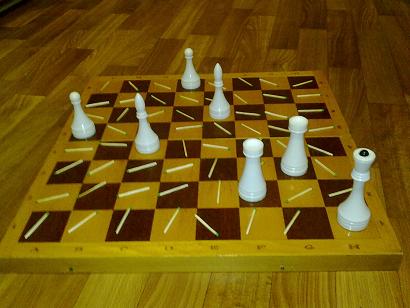Chess Puzzles
Chess Puzzles F.A.Q.
Why play Nim?
Training in chess, or/and training in math, or/and training in computer science. It depends on the way your will solve the puzzles.
What Nim trains?
There are two main applications of the chess nim: chess moves imagination and game theory practice. Depending on the goal of training you should solve the problem that or another way.
In-deep vision in chess
Nim is many times simpler game than chess, but it teaches why single move is so important and how to think many moves forward.
First of all you should find out couple end positions of the game - in these positions the winner is obvious.
Second element of approach is to find out properties of figures.
Finally, having these obvious positions and knowing some general properties of the game, you will need to find out the correct move. That is possible by detecting wrong moves. That will show you the chess trick: key to the victory is in limiting of opponent moves.
Math puzzle
For mathematician or computer scientist the game is good example of an approach he provides. For example, solution could be represented by a game tree, statistical model or by heuristic algorithm.
Also the game demonstrates how mentioning of properties may reduce computation difficulty. For example, don't miss equality of the verticals in pawn duel or symmetry in rook and queen nim. It will reduce computation difficulty much. However, different approaches are also possible.
How to win in Queen Nim?

You may see the solution at the chess board left hand. At the board chess figure marks a winning cell and a match shows a cell you should not put the queen, because if your opponent knows ideal strategy (it is still left hand) he will definitely win.
How this solution was found?
By rules one who puts the queen to left-bottom corner (H1) wins, so we can mark it by figure, obviously we
need to mark first horizontal, H vertical and main diagonal by matches (figure can reach the cell iff it was on the mentioned lines).
We see that F2 and G3 are not marked on the next step. This means - they are winning ones (opponent will definitely have to make move to "wrong"
cell, having no winning cells available from the positions). And we need to mark two sub-diagonals, second & third horizontals and F & G verticals at this step.
The same considerations are applied on the next two steps till the board becomes completely marked.
Such approach is called "Dynamic Programming". As you see, its concept assumes breaking a problem on steps, having it solved partially on each step and using results from previous step only. The method is powerful, but it should be said that not all problems could be solved by this method. You could practice the method by solving Rook, Rook-2, Rook-3, Queen-2 and Queen-3 puzzles.
Pawn duel origin
Pawn duel is a kind of Nim game. The author of the game was not completely identified. However, more common variant of the game (with various number of pawns and no restriction on the first move) is known as Northcott's Nim.
The solution of regular Nim requires from a player to maintain Nim zero sum. This rule is very useful to know for Pawn duel.
Pawn duel winning strategy equals to regular Nim strategy after the first move. Thus first move of black pawns also complies the Nim zero sum rule.
Northcott showed that backward moves have no effect on the strategy as long as winning player can compensate each backward move of the opponent moving a piece in the same row equally forward.
|
© 2012, AnyIntelli Inc. |
